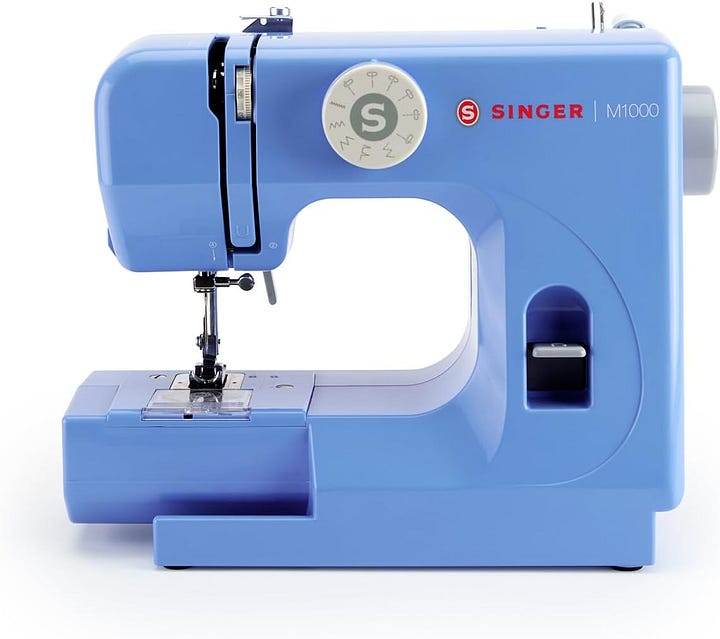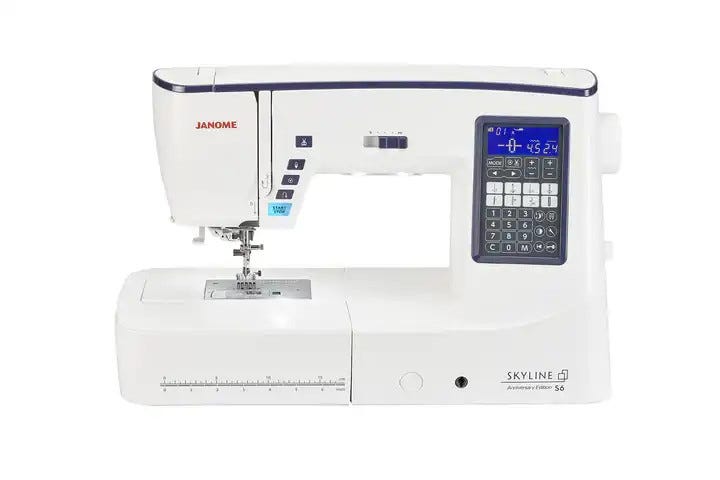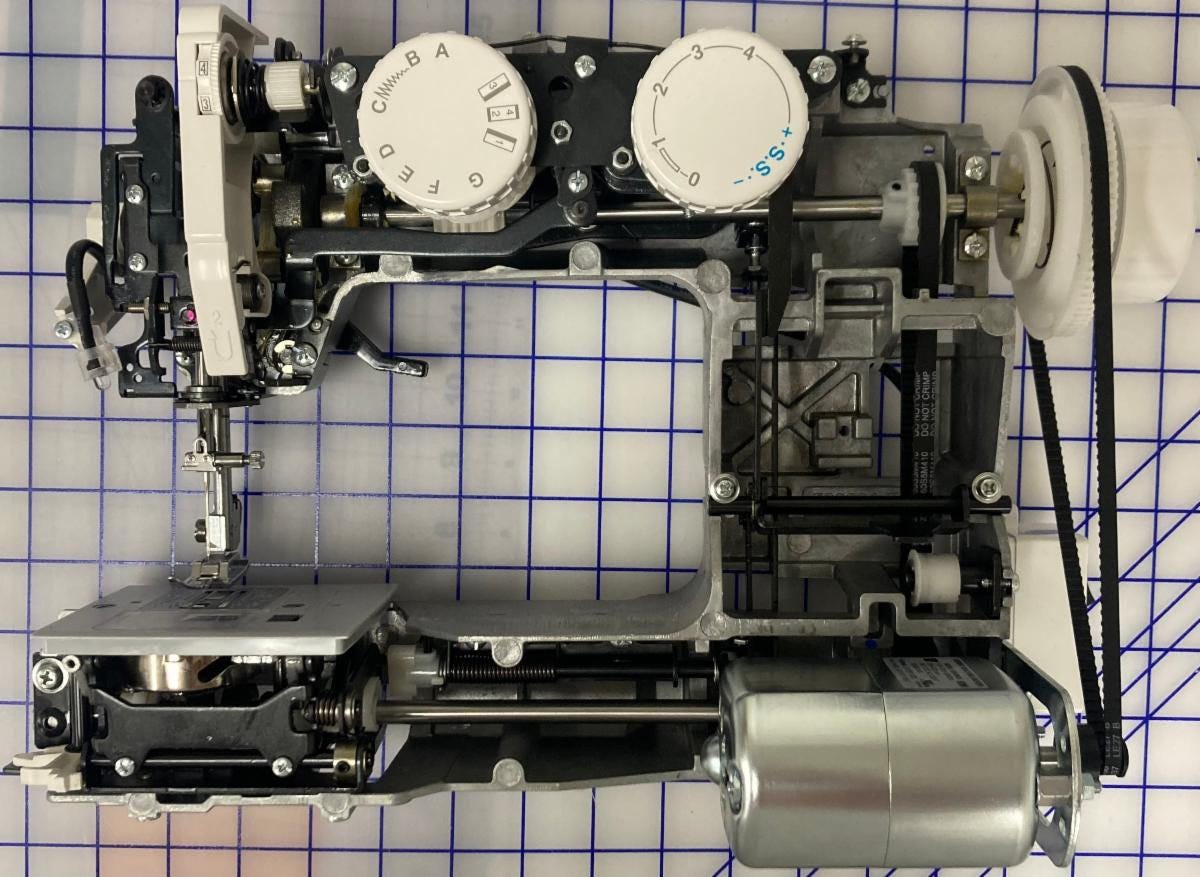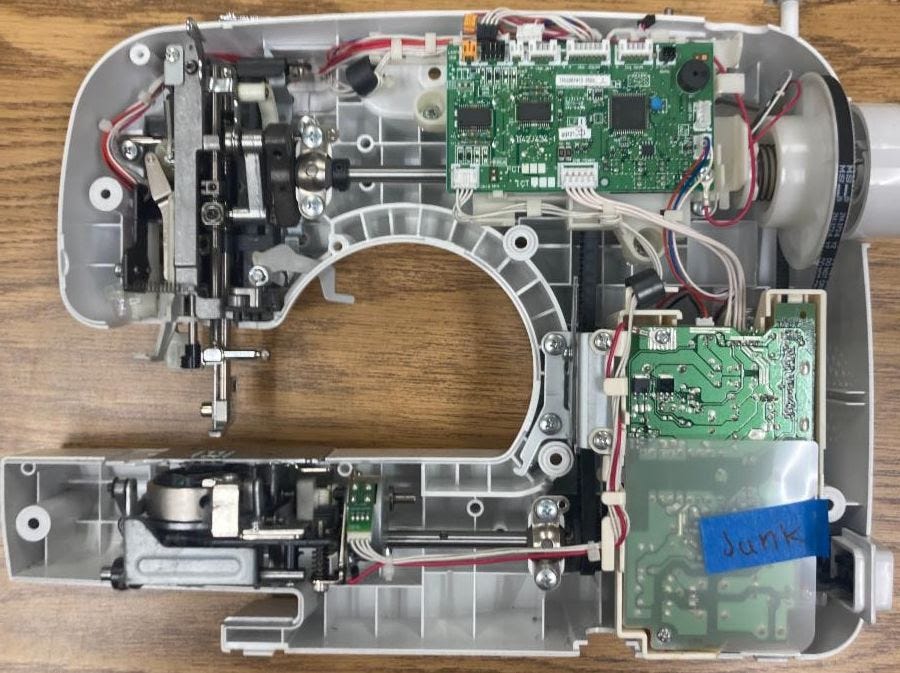Greetings everybody,
In this edition of The Sewing Machine Newsletter, we'll explore the differences between two types of sewing machines available in 2025: those crafted with durable metal housing and those built without it.
Or, to put it simply—tools versus toys.
Although I've touched upon this topic before, I believe it's important to revisit and emphasize clearly. I hope you find this information valuable.
— Cale
Tool vs Toy
Tool: a device or implement, especially one held in the hand, used to carry out a particular function.
Toy: an object for a child to play with, typically a model or miniature replica of something.


Sewing machines are tools.
A sewing machine is a tool we use to securely stitch two or more pieces of material together. Unfortunately, there is an entire category of sewing machines that aren't built like reliable tools. Instead, they're manufactured more like plastic children's toys. To know whether an individual sewing machine model is built like a tool or a toy, simply check to see if the machine has metal housing.

Think of the housing as a foundation for a home. No home is of high quality if it doesn't have a solid, well-built foundation, and that is what we have here. All the critical components of the machine are attached to a one-piece all-metal housing: the needle bar assembly, hook assembly, feed dogs, upper shaft, lower shaft, etc.
You can actually remove both the front cover and back cover completely and sew on the machine without them:
Sewing Machines Built like Toys
You might be wondering how a sewing machine can even be built without metal housing. I can show you.
Below is a photograph of the guts of a machine that is a best seller on Amazon, given the prestigious label of "Amazon's Best Choice." Have you ever seen the inside of a cheap plastic toy a kid might play with where all the internal parts are attached to the plastic cover? This machine is not so different than that:

Unlike the aforementioned metal housing Janome model, I cannot take the plastic back cover off of this machine because the back cover is the housing. All the internal components are screwed in with self-tapping screws to the back cover of the machine, which is simply a one-piece plastic cover.
Why is Plastic Housing a Problem?
The way a sewing machine makes a successful stitch, there is very little room for error. Consider the relationship between bent needles and skipped stitches. If a slightly bent needle can cause failure to make a stitch, imagine how a poorly constructed foundation could cause problems. If all the internal components are housed in the plastic foundation and the plastic foundation bends/warps, every component on the machine can become misaligned.
For example, every time the needle pierces through the fabric, there is a moment of impact. The force of the needle piercing the fabric reverberates up the needle, into the needle bar, into the needle bar mechanism. Ultimately, it is the machine’s foundation that absorbs that impact. Over a long time horizon, that constant impact shouldn’t be a problem if the foundation is made of metal. However, if the foundation is made of plastic, it’s a whole other story— especially if we accidentally sew over a pin or zipper or something of the like. The needle bar can shift out of place. The machine can get thrown out of time. The upper shaft and lower shaft can become misaligned. In other words, a machine with plastic housing is far more susceptible to injury.
Beyond being notorious for not holding up over time, these plastic toy machines are also a pain for technicians to fix. For example, when re-attaching the front cover, if you tighten the screw that holds the two covers together too tight, the entire upper shaft will torque in a way that throws off needle-hook clearance, a setting whose precision is critical for the machine's ability to make a successful stitch. That is why our store has a policy when someone brings in this machine to be repaired: we’ll fix it if you insist, but recommend you take the money you’d spend on repair and instead invest it towards a new machine that will last you 20+ years.
Thank You For Reading!
Working at The Sewing Machine Shop, I've encountered numerous customers who remain loyal to their older sewing machines and resist considering newer models. Often, their primary concern is that “modern machines are all made out of plastic.”
I understand their hesitation. Many have likely tried modern machines only to be disappointed by cheaply built models. It's unfortunate because modern sewing machines offer numerous exciting features—needle threaders, automatic thread trimmers, pivot functions, decorative stitches, electric presser foot lifts, enhanced throat space, and more. If only they had chosen a machine with sturdy metal housing!
Sadly, some of the world's most popular sewing machines today are toys disguised as tools. It was particularly disheartening to see Wirecutter, the reputable product review site from The New York Times, recently rank a sewing machine with plastic housing as the top choice for beginners. This recommendation directly contradicts my perspective on quality sewing machines. I prioritize metal housing above all other features and aim to clearly communicate its importance, hoping to influence the broader sewing community toward recognizing and valuing durable, metal-housed machines.
—Cale




Great article. Wish more sewists would get on board with this. It takes the joy out of creating when the machine does not produce good results.
Great article. I still use my mom’s 58 Singer… it sits beside my 2022 Brother. I end up using both often.